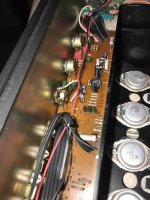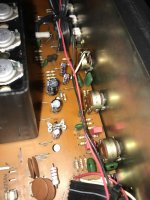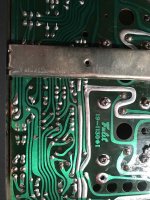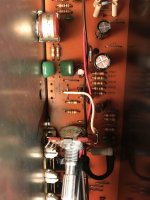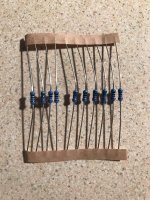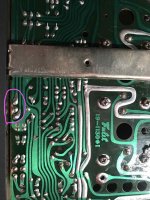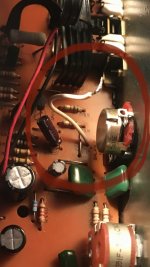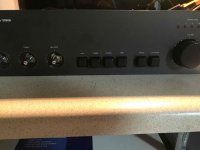Hi,
Can anyone recommend a replacement balance pot for the NAD 3020A?
Also, has anyone successfully removed the balance pot from the circuit whilst leaving it physically in place? This modification has probably been reported on the forum, just haven’t managed to locate it.
My power amp has separate channel volume controls so the absence of the balance function on the NAD would probably work fine for me at this time.
Many thanks.
Can anyone recommend a replacement balance pot for the NAD 3020A?
Also, has anyone successfully removed the balance pot from the circuit whilst leaving it physically in place? This modification has probably been reported on the forum, just haven’t managed to locate it.
My power amp has separate channel volume controls so the absence of the balance function on the NAD would probably work fine for me at this time.
Many thanks.
Basically the balance control is connected to both channel outputs in the preamp section and the slider is connected to the earth so varying it lowers the resistance value to earth so reducing the output signal depending on the direction you turn it for each channel.
If you want to leave it in place just remove ( unsolder ) the centre slider tab on the control .
If you want to leave it in place just remove ( unsolder ) the centre slider tab on the control .
As Duncan suggests, this a just a simple linear pot. and any decent quality 20K linear pot. of the appropriate shaft size, length (may require trimming) and connection terminal style will do. If you want to eliminate it but ensure you still had the same overall level as previous, you might replace the balance pot with 2 x 10K 1/4W shunt resistors, each wired from the same preamp output (L or R) signal points to the same common ground connection. The L-R balance may not be as precisely centred as you'd like, but a small adjustment of the appropriate shunt resistor value will soon fix that.
Last edited:
Thanks Duncan and Ian.
Re; '10K 1/4W shunt resistors'.. would these be appropriate?
https://uk.farnell.com/multicomp/mf...PPING-SMART-PASSIVES-Test726&gross_price=true
Re; '10K 1/4W shunt resistors'.. would these be appropriate?
https://uk.farnell.com/multicomp/mf...PPING-SMART-PASSIVES-Test726&gross_price=true
Yes they would do you are not going to worry about current noise so much as there will not be a big generation of current in the preamp signal output , in any case at 10K or 20K the spectral density for current noise drops and thermal noise which is lower predominates .
You could buy expensive resistors but I don't see the advantage in reference to your amplifier it would just be overkill.
You could buy expensive resistors but I don't see the advantage in reference to your amplifier it would just be overkill.
re: the fixed resistor dodge -
Lets assume you know that a potentiometer (pot) starts out with a fixed resistance of the nominal value marked on the side or back. That resistance is connected at either end, between the 2 outer pot. terminals. The sliding contact is the variable resistance connection, located in the centre. Check this with a multimeter so you know what you are actually doing when you turn the pot. and thus be able to emulate any particular setting and fine adjustments, if needed. (you will likely need fine trimming of the resistors to get the balance 'just so' in a given stereo setup, if you are fussy).
So...the balance pot is a single gang, 20K ohms linear type and located in the preamp section with the outer pins wired to either L or R channel (hot) output. The centre pin is connected to signal ground. To emulate the pot at its centre setting, just remove the three pot leads from the PCB (located as circled on your pic) and bridge both outer PCB pads to the centre pad terminal with 10k resistors, because 10+10k=20k, which is equivalent to the pot when it's set at its centre position. I also suggest you keep all lead lengths to a minimum and remove the old pot leads to avoid adding any stray hum and noise to the signal.
Otherwise, it's Voila! ......a simple and quick dodge.
Lets assume you know that a potentiometer (pot) starts out with a fixed resistance of the nominal value marked on the side or back. That resistance is connected at either end, between the 2 outer pot. terminals. The sliding contact is the variable resistance connection, located in the centre. Check this with a multimeter so you know what you are actually doing when you turn the pot. and thus be able to emulate any particular setting and fine adjustments, if needed. (you will likely need fine trimming of the resistors to get the balance 'just so' in a given stereo setup, if you are fussy).
So...the balance pot is a single gang, 20K ohms linear type and located in the preamp section with the outer pins wired to either L or R channel (hot) output. The centre pin is connected to signal ground. To emulate the pot at its centre setting, just remove the three pot leads from the PCB (located as circled on your pic) and bridge both outer PCB pads to the centre pad terminal with 10k resistors, because 10+10k=20k, which is equivalent to the pot when it's set at its centre position. I also suggest you keep all lead lengths to a minimum and remove the old pot leads to avoid adding any stray hum and noise to the signal.
Otherwise, it's Voila! ......a simple and quick dodge.
Ian, thank you so much for the guidance.
However, when I disassembled the balance pot I cleaned it and it's incredibly accurate throughout the range on a DMM so I've decided to simply replace it. However.. powering on the amp, whether the white cable that was originally connected to the top of the balance pot is reconnected or disconnected makes no difference audibly to the sound output. Even the action of touching the wire to the pot makes no scratching noise or anything. I'm surprised but I suppose I should reconnect it as it's been that way since purchased new in 1984..
Any forensic comments from other DIYers welcome..
However, when I disassembled the balance pot I cleaned it and it's incredibly accurate throughout the range on a DMM so I've decided to simply replace it. However.. powering on the amp, whether the white cable that was originally connected to the top of the balance pot is reconnected or disconnected makes no difference audibly to the sound output. Even the action of touching the wire to the pot makes no scratching noise or anything. I'm surprised but I suppose I should reconnect it as it's been that way since purchased new in 1984..
Any forensic comments from other DIYers welcome..
Attachments
Going by the schematic for a 3020 the centre slider goes to earth and this should reduce the preamp output depending on the direction of the balance control .
If you are saying you cannot reduce the output on either preamp output then check the earthing of the control to make sure its earthed .
The balance control is straight across both preamp channel outputs so should have an effect on each of them.
If you are saying you cannot reduce the output on either preamp output then check the earthing of the control to make sure its earthed .
The balance control is straight across both preamp channel outputs so should have an effect on each of them.
The white wire which is usually connected to that pot. grounds a 50% tap.
If you've desoldered the wire at the pot end, then you have one end of the wire soldered to the amp pcb and you're touching the other end to the pot casing, all you're doing is connecting between 2 GND points. It should be reconnected to the correct terminal on the top of the pot, then it should have an effect.
If you've desoldered the wire at the pot end, then you have one end of the wire soldered to the amp pcb and you're touching the other end to the pot casing, all you're doing is connecting between 2 GND points. It should be reconnected to the correct terminal on the top of the pot, then it should have an effect.
A tapped variable resistor has been used in radios from the early 30,s as a "loudness " control .
I notice the photo you have supplied shows an actual loudness switch on the front panel .
Looking at my own 3020 it looks identical therefore when the switch is depressed that should make the loudness circuit active .
I will also look in my USA old radio manual as it lists very old US radios .
If you want I will open up mine to have a look.
I notice the photo you have supplied shows an actual loudness switch on the front panel .
Looking at my own 3020 it looks identical therefore when the switch is depressed that should make the loudness circuit active .
I will also look in my USA old radio manual as it lists very old US radios .
If you want I will open up mine to have a look.
Thanks Duncan. I think you may be right, as I have a loudness button on the front as well as a loudness tapped volume pot.
My latest gremlin is that when the ‘mono’ button is depressed whilst 'phono' is selected... the sound comes out as though it’s been put through some sort of effects process, the sound recedes but presents as though recorded with slight echo...
However, on aux or tuner the sound is ‘perfect’ really good, the problem is only with phono.
My latest gremlin is that when the ‘mono’ button is depressed whilst 'phono' is selected... the sound comes out as though it’s been put through some sort of effects process, the sound recedes but presents as though recorded with slight echo...
However, on aux or tuner the sound is ‘perfect’ really good, the problem is only with phono.
Looking again at the circuit diagram the volume control is tapped to provide a RC network ( resistance/capacitance on the phono of both channels , this can be switched out ( according to the diagram ) as can the tone control circuit be bypassed .
This might provide a clue as to the centre tap being not connected , this - well excuse me please here - "abomination " of "loudness " goes against all my feelings as to the purity of an audio circuit --what the heck !---I Hate them and were short era "phobia " of probably some manufacture,s Sales Dept . to help sell their products .
This might provide a clue as to the centre tap being not connected , this - well excuse me please here - "abomination " of "loudness " goes against all my feelings as to the purity of an audio circuit --what the heck !---I Hate them and were short era "phobia " of probably some manufacture,s Sales Dept . to help sell their products .
The tap on the balance pot effectively only grounds the mid-point of the (non-linear, W-taper) pot, so should have some effect, although I suspect it may be (very) small in audible terms. It has nothing to do with the any of the other controls.
The tap on the volume pot is connected to an RC network that is actually the loudness circuit, which can be switched on / off, and which affects any of the inputs not just phono. The RC network is responsible for the frequency 'shaping' inherent to the loudness circuit.
The tone controls cannot be bypassed in the 3020A - there is a 'mute' switch which obviously mutes the (pre-amp) output, but there's no tone control circuit bypass as such, not that I've ever seen.
The tap on the volume pot is connected to an RC network that is actually the loudness circuit, which can be switched on / off, and which affects any of the inputs not just phono. The RC network is responsible for the frequency 'shaping' inherent to the loudness circuit.
The tone controls cannot be bypassed in the 3020A - there is a 'mute' switch which obviously mutes the (pre-amp) output, but there's no tone control circuit bypass as such, not that I've ever seen.
- Home
- Amplifiers
- Solid State
- NAD 3020A - replacement balance pot - bypass balance pot
